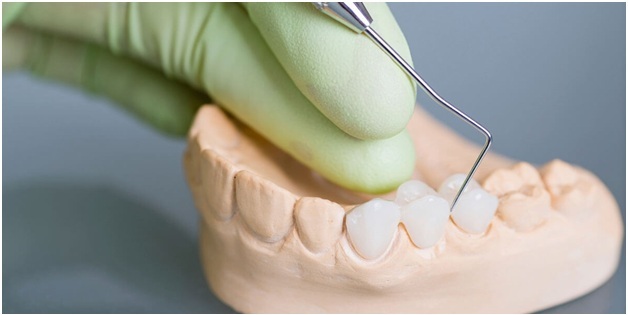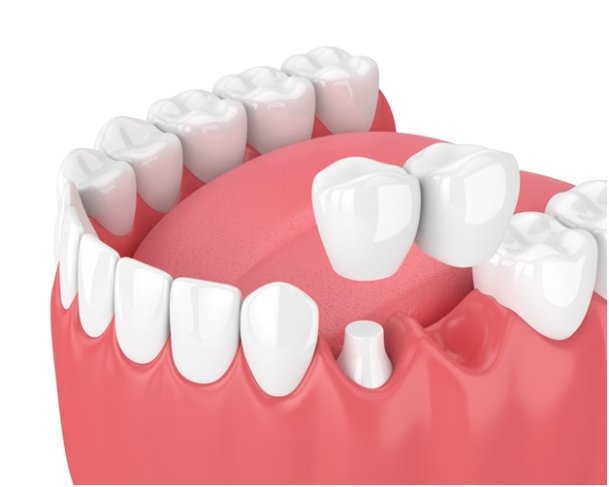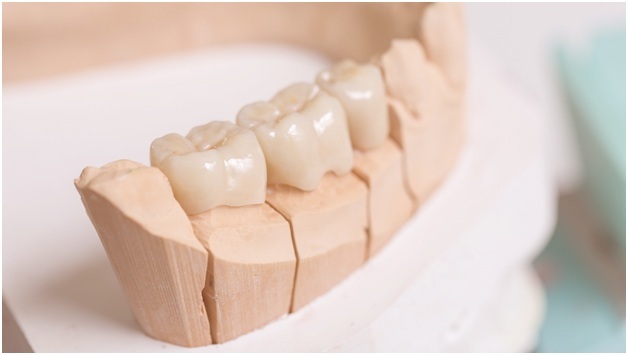Dental bridgesare false teeth, also known as “pontic”, put together between two porcelain crowns filling in the gapcaused by a missing or extracted tooth. The two crowns are fused to your teeth on each side of the false tooth to keep it in place – this is called the “fixed bridge”. This dental procedure replaces one or more missing teeth.
You cannot remove a fixed bridge easily as you will do with a denture. You can click on https://www.nuviasmiles.com/blog/dentures-vs-bridges to learn more about the differences between dentures and bridges.

Types of Bridges
There are several types of dental bridges, each with advantages and disadvantages. We’ll consider four of them below.
Traditional Dental Bridges
Traditional dental bridges are made of porcelain and secured to two teeth on either side of the missing tooth. They’re used to replace a single missing tooth.
The main advantage of this type of bridge is that it’s simple; there aren’t any additional pieces or materials involved in their creation. This makes it easier for you to get them done quickly. However, traditional dental bridges do have some drawbacks—in particular:
- They’re not as stable as alternatives like implants or partial dentures because they don’t feature any natural support from surrounding teeth
- They can break easily because they don’t contain any kindling material (like metal screws).
Cantilever Bridges

A cantilever bridge is a dental implant attached to the jawbone in place of a missing tooth or teeth. The bone is reinforced with titanium, making it strong enough to support the weight of your new implant.
Cantilever bridges are made from plastic materials and have an arch-like shape. They can be in any style you choose as long as they meet criteria set by your dentist, including length and width, and color choices (white/clear).
A typical implant costs between $1-2k depending on location and material used. You should expect this cost to go up slightly if you want something more elaborate than basic white resin models.
Maryland Bonded Bridges (also called resin-bonded bridges or Maryland bridges)
These are from a mixture of porcelain and resin placed on either side of the missing tooth. This process can take up to six months and requires additional care. So, you must consult dentists or periodontists, who will check that your teeth are healthy enough for this kind of treatment.
Implant-supported Dental Bridges
Dental implants are placed into the jawbone then a dental bridge is placed over them to replace missing teeth. The bridge can be made of metal or porcelain and rests on the implant crowns.
The advantages of this type of replacement include:
- It’s long-lasting—the tooth roots will last up to 20 years before they need replacing again.
- It provides both aesthetic functions as well as comfort through its natural appearance.
- You won’t have any problems with sensitivity or irritation from wearing them for extended periods at a time. This is because there is no visible wire between your gums and bone like in traditional bridges (which tend not to fit perfectly).
Benefits of Dental Bridges

Dental bridges are a permanent solution to missing teeth and can be used to treat several oral health conditions.
Dentists may recommend this option if you have missing teeth or if your remaining teeth are not in the right position. This is because it provides support in replacing several missing teeth.
With bridges, those who need them can chew food easily and speak more clearly than before they lost their natural bone structure.
We’ll highlight a few benefits of bridges in this section.
A Permanent Solution to Missing Teeth
Dental bridges are an alternative to dentures and can provide a more durable and comfortable solution to missing teeth.
They consist of two or more crowns that bridge a gap in your mouth. This replaces all or part of the lost tooth. They’re often best for people with periodontal disease (gum disease) or loose teeth.
The permanent nature of dental bridges means they can last for many years without needing replacement. This makes them ideal for those who want long-term wearability but may not be ready for full mouth reconstruction yet.
It is important to note that although dental bridges are better than dentures, they require regular care like cleaning and checkups at the dentist’s or hygienist’s office. So, as you consider this option, also commit time to care for it.
Prevents the Remaining Teeth from Drifting Out of Position
Dental bridges are a great way to prevent the teeth from drifting out of position. The reason is that the bridge is attached to the teeth on either side of the missing tooth. This helps to maintain facial structure and can also prevent further tooth decay.
Maintains Facial Structure
The facial structure is a vital part of your overall health. If you have missing teeth, or poor teeth alignment and spacing, the damage to your facial structure can lead to problems such as:
- Painful headaches
- Difficulty chewing food properly
- Jaw pain due to misalignment of the jawbone
Improves Speech and Ability to Chew Correctly
Bridges replace the gap between teeth, letting you chew and speak comfortably. The best part is that they can improve your speech and ability to chew correctly.
The metal brackets are designed for each patient to ensure proper bite alignment. So, there’s less chance of misaligned teeth or food getting stuck in between them during chewing.
They also help to improve digestion and weight loss by helping you process food more efficiently through the saliva glands in your mouth. Due to this, there are also fewer chances of constipation caused by tooth decay. You can read this article to learn more about how tooth decay causes constipation.
Disadvantages of Dental Bridges
Dental bridges are a popular option for people who want to replace missing teeth. However, there are some disadvantages to this dental procedure. Let’s consider some of them below.
High Cost
Dental bridges are a more expensive choice than dentures and can be hard to repair if damaged. They require multiple visits to the dentist and have a much higher failure rate than other less-invasive treatments.
Also, regular activities such as brushing your teeth with fluoride toothpaste can damage them. So, dental bridges can be costly in the long run if you need to have another root canal or crown.
In addition, bridge replacement is generally not covered by insurance due to its high-cost relative to other types of restorative work (such as filling cavities). So, you’ll need to pay out of pocket or ask your dentist about financing options.
If you have dental insurance coverage through work or Medicare Part D (a prescription drug plan), ensure that your employer pays for all or part of it. Or else, try getting funding from friends & family members who may provide loans or gifts, as well as financial aid programs offered by schools and colleges around town.
Some other affordable dental care options don’t involve major surgery but still provide lasting solutions. However, discuss these options with your primary care provider before deciding what kind of treatment plan would best suit your needs.
Possible Nerve Damage

During the procedure, the dentist will file down your teeth to put the bridges in place. This may result in nerve damage, a root canal, and increased sensitivity.
However, if you’re unprepared for this, you can opt for a removable partial denture. The advantage is that your smile will still be beautiful and natural looking.
Conclusion
There are many dental bridges for different needs and budgets, but one of the most popular is a hybrid fixed bridge. This type has a removable crown used for chewing, talking, or eating without affecting your speech or facial structure. You can also consider an implant-supported bridge because it doesn’t require additional work from your dentist before inserting it. However, discuss your options with a dentist to get the best solution for your teeth.

